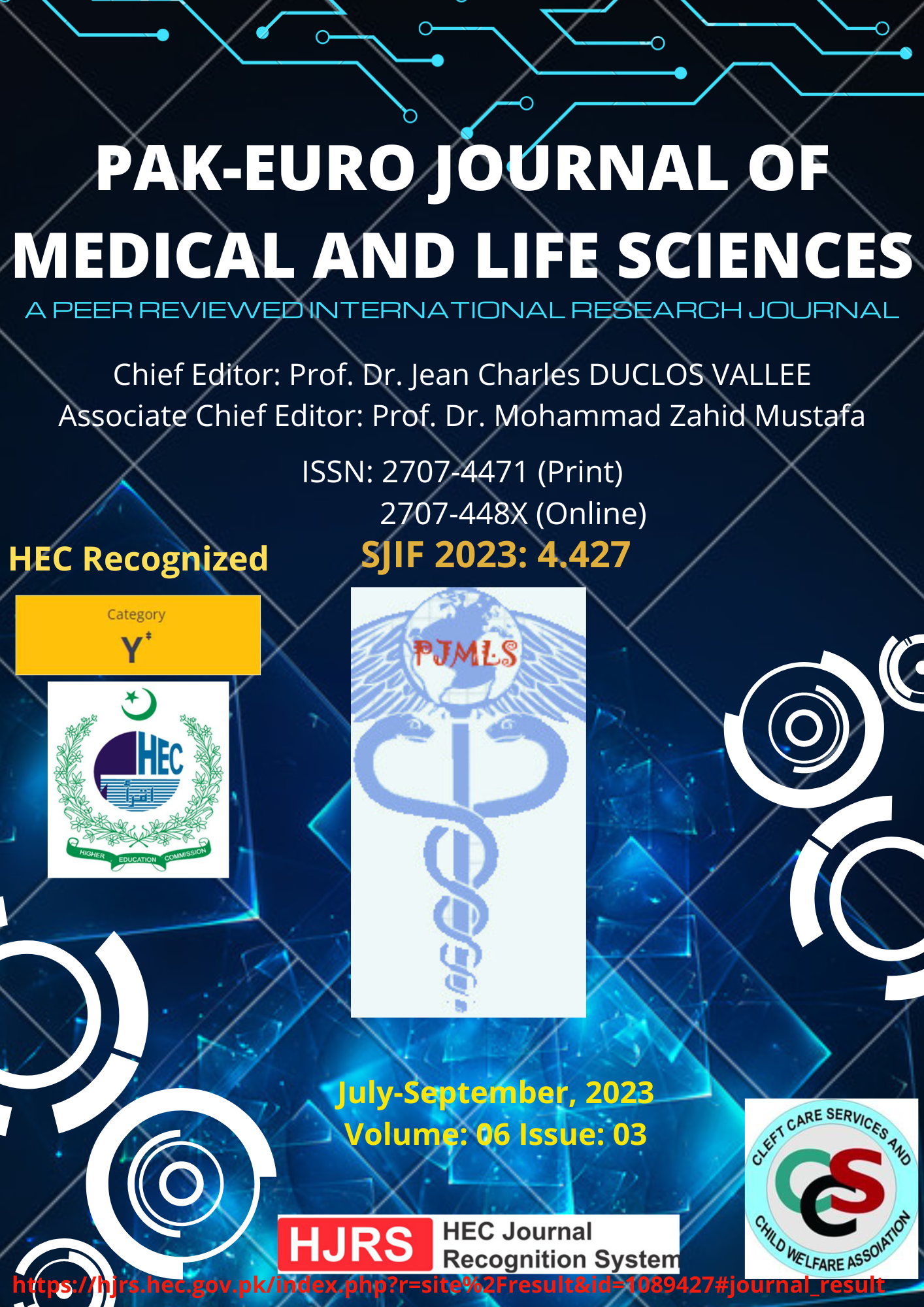Novel Methodology for Washing of Chromium Contaminated Soil Using Biosurfactant in Pakistan
DOI:
https://doi.org/10.31580/1vc07q10Keywords:
Biosurfactant, Bioremediation, Chromium, Heavy metals, Optimization, Pseudomonas aeruginosa, Rhamnolipid, Washing of soil, Waste treatmentAbstract
Chromium is acutely toxic, mutagenic, and carcinogenic for all forms of life. Industrial sources release chromium thus contaminating water and soil. As biosurfactants are natural, easily degradable, non-toxic, environment-friendly, and cost-effective products, we have applied them here for bioremediation and prepared rhamnolipids as biosurfactants. Rhamnolipids were prepared by using Pseudomonas aeruginosa in mineral salt (MS) media at pH 7 and kept in an incubating shaker for 48 hours at 37oC. Centrifugation was used to extract the cells from the culture broth and cell-free broth was later used for washing the soil. K2Cr2O7 was used for soil spiking. By optimizing different variables like pH, time, concentration of chromium, dilution of rhamnolipids, and percentage removal of chromium was studied Best removal (89.25%) of chromium was obtained in 6 hours using 3:1 rhamnolipid dilution for 500 ppm of K2Cr2O7 at pH 4. However in some cases, after 24 hours, as rhamnolipid started releasing chromium, a decrease in chromium removal percentage has been observed which represents the mechanism shift from micelle remediation to reduction one and causes reduction of Cr+6 to insoluble Cr+3. Results of the present research suggested that microbial metabolites such as biosurfactants are found to be significantly efficient for the removal of chromium (89.25%) from the contaminated soil.References
Dhaliwal SS, Singh J, Taneja PK, Mandal A. Remediation techniques for removal of heavy metals from the soil contaminated through different sources: a review. Environmental Science and Pollution Research. 2020;27:1319-33.
Sharma P, Pandey AK, Kim S-H, Singh SP, Chaturvedi P, Varjani S. Critical review on microbial community during in-situ bioremediation of heavy metals from industrial wastewater. Environmental Technology & Innovation. 2021;24:101826.
Ajiboye TO, Oyewo OA, Onwudiwe DC. Simultaneous removal of organics and heavy metals from industrial wastewater: A review. Chemosphere. 2021;262:128379.
Kumar V, Thakur IS, Shah MP. Bioremediation approaches for treatment of pulp and paper industry wastewater: Recent advances and challenges. Microbial bioremediation & biodegradation. 2020:1-48.
Khalid N, Rizvi ZF, Yousaf N, Khan SM, Noman A, Aqeel M, et al. Rising metals concentration in the environment: a response to effluents of leather industries in Sialkot. Bulletin of Environmental Contamination and Toxicology. 2021;106:493-500.
Xie B, Shan C, Xu Z, Li X, Zhang X, Chen J, et al. One-step removal of Cr (VI) at alkaline pH by UV/sulfite process: reduction to Cr (III) and in situ Cr (III) precipitation. Chemical Engineering Journal. 2017;308:791-7.
Rengaraj S, Yeon K-H, Moon S-H. Removal of chromium from water and wastewater by ion exchange resins. Journal of hazardous materials. 2001;87(1-3):273-87.
Anupam K, Dutta S, Bhattacharjee C, Datta S. Adsorptive removal of chromium (VI) from aqueous solution over powdered activated carbon: Optimisation through response surface methodology. Chemical Engineering Journal. 2011;173(1):135-43.
Laboratory NRMR. In Situ Treatment of Soil and Groundwater Contaminated with Chromium: Technical Resource Guide: United States, Environmental Protection Agency, National Risk Management …; 2000.
Sarankumar RK, Arulprakash A, Devanesan S, Selvi A, AlSalhi MS, Rajasekar A, et al. Bioreduction of hexavalent chromium by chromium resistant alkalophilic bacteria isolated from tannery effluent. Journal of King Saud University-Science. 2020;32(3):1969-77.
Nacorda JOO, Martinez-Goss MR, Torreta NK. Bioremoval and bioreduction of chromium (VI) by the green microalga, Chlorella vulgaris Beij., isolated from Laguna de Bay, Philippines. Philippine Journal of Science. 2010;139(2):181-8.
Battersby NS. The biodegradability and microbial toxicity testing of lubricants–some recommendations. Chemosphere. 2000;41(7):1011-27.
Haba E, Pinazo A, Jauregui O, Espuny M, Infante MR, Manresa A. Physicochemical characterization and antimicrobial properties of rhamnolipids produced by Pseudomonas aeruginosa 47T2 NCBIM 40044. Biotechnology and bioengineering. 2003;81(3):316-22.
Ochoa‐Loza FJ, Artiola JF, Maier RM. Stability constants for the complexation of various metals with a rhamnolipid biosurfactant. Journal of environmental quality. 2001;30(2):479-85.
Tan H, Champion JT, Artiola JF, Brusseau ML, Miller RM. Complexation of cadmium by a rhamnolipid biosurfactant. Environmental science & technology. 1994;28(13):2402-6.
Bai M, Liu Z, Liu Z, Yu H, Lu L. Removal of mixed contaminants from landfill leachate–contaminated soil by flushing with bio-surfactant: laboratory column tests. Environmental Science and Pollution Research. 2023;30(18):53702-11.
Kholghi N, Amani H, Malekmahmoodi S, Amiri A. Investigation on heavy metal removal from a crude oil contaminated soil using rhamnolipid biosurfactant as a new eco-friendly method. Tenside Surfactants Detergents. 2020;57(6):515-20.
Yu Q, Li H, Zheng Y, Jiao B, Li D. Promoted electrokinetic treatment of Cr from chromite ore processing residue with rhamnolipid: Focusing on the reactions on electrolyte-residue interfaces. Journal of Environmental Chemical Engineering. 2022;10(1):106954.
Fardami AY, Kawo AH, Yahaya S, Riskuwa-Shehu ML, Ahmad SA, Lawal I, et al. Rhamnolipid Biosurfactant Produced by Enterobacter Cloacae AYF1 Strain Enhanced the Remediation of Heavy Metal Contaminated Water. 2022.
Santa Anna L, Sebastian G, Menezes E, Alves T, Santos A, Pereira Jr N, et al. Production of biosurfactants from Pseudomonas aeruginosa PA 1 isolated in oil environments. Brazilian Journal of Chemical Engineering. 2002;19:159-66.
Morán AC, Olivera N, Commendatore M, Esteves JL, Siñeriz F. Enhancement of hydrocarbon wastebiodegradation by addition of a biosurfactantfrom Bacillus subtilis O9. Biodegradation. 2000;11:65-71.
Chen C-Y, Baker SC, Darton RC. The application of a high throughput analysis method for the screening of potential biosurfactants from natural sources. Journal of Microbiological Methods. 2007;70(3):503-10.
Chen W, Qu Y, Xu Z, He F, Chen Z, Huang S, et al. Heavy metal (Cu, Cd, Pb, Cr) washing from river sediment using biosurfactant rhamnolipid. Environmental Science and Pollution Research. 2017;24(19):16344-50.
Wu L-m, Lai L, Lu Q, Mei P, Wang Y-q, Cheng L, et al. Comparative studies on the surface/interface properties and aggregation behavior of mono-rhamnolipid and di-rhamnolipid. Colloids and Surfaces B: Biointerfaces. 2019;181:593-601.
Beal R, Betts W. Role of rhamnolipid biosurfactants in the uptake and mineralization of hexadecane in Pseudomonas aeruginosa. Journal of Applied Microbiology. 2000;89(1):158-68.
Downloads
Published
Issue
Section
License
Copyright (c) 2023 Pak-Euro Journal of Medical and Life Sciences

This work is licensed under a Creative Commons Attribution 4.0 International License.






